I
Hindemith's title of his four-movement von Weber suite of 1943 poses a problem. The composer's characteristic reticence about his sources delayed their documentation for some twenty years, whereupon it was found that the Symphonic Metamorphosis was based, not only on themes, but on complete pieces.1 Rather than "thematic transformation," the "metamorphosis" of the title would thus be more accurately regarded as "re-composition," in which changes of tone system, timbre, harmony, rhythm, and form, in addition to the melody itself, transform every level and component of the original composition's structure.2 This study attempts to demonstrate how Hindemith achieves such a metamorphosis in the "Turandot Scherzo" through a compositional process of thesis, antithesis, and synthesis, with, as a catalyzing agent, rhythm or the manipulation of time.
The metamorphosis of the Turandot theme began long before Hindemith's attraction to it. Initially von Weber borrowed the melody from Jean-Jacques Rousseau's Dictionnaire de musique of 1768 for his aborted Overtura Chinesa of 1804, which he revised and expanded five years later into incidental music for Schiller's drama, Turandot, hence its name. Rousseau, in turn, had taken the tune from the third volume of Jean-Baptiste du Halde's Description géographique, historique, politique, et physique de l'empire de la Chine et de la Tartarie Chinoise of 1735, in which it was included with five other "Chinese airs" sent to the Jesuit scholar by Catholic missionaries.3
Example 1 tabulates the four relevant versions of the Turandot melody, with Hindemith's transposed up a major second to facilitate comparison.
Example 1
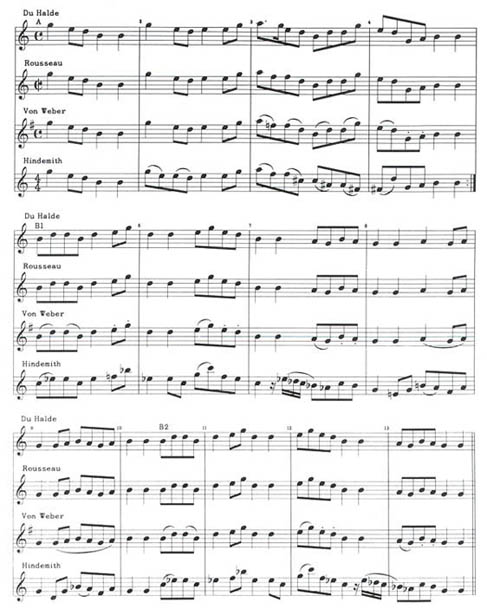
The original air's most conspicuous harmonic and formal characteristics comprise a pentatonic tone system (G-A-B-D-E-G) and a division into three unequal phrases of 4, 5½, and 3½ bars (labeled respectively A, B1, and B2). By accident or design Rousseau's minor but not insignificant changes "modernized" the tune by eliminating the dotted rhythm in the first half of bar 3, possibly to mirror the rhythm of the second half, and by introducing, in the same bar, a sixth note, F, into the pentatonic tone system, suggesting the Mixolydian mode. Von Weber's provision of a key signature modernized the melody further by implying a tone system of G Major with an altered seventh rather than Mixolydian, whose modal character he further eroded or eliminated entirely in subsequent variations. Hindemith extended the tune's evolution into the twentieth century by combining symmetry of form—the repeated A section plus B1 and B2 make four phrases of almost equal length—with a chromatic tone system resulting from a mixture of the Mixolydian and Locrian modes (see Example 2).4
Example 2
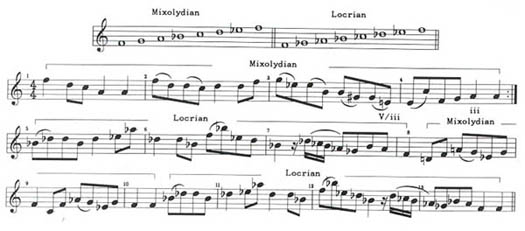
II
The dialectic of Hegelian metaphysics is suggested by much of Hindemith's music, which, it may be said, begins with a statement of a problem or thesis, continues with a contradiction of the problem or antithesis, and concludes with a resolution of the problem, or synthesis. The thesis of the "Turandot Scherzo" is presented in the Introduction (bars 1-27)—a series of intonations by the chimes of the first four notes of the Turandot theme (F-D-C-A) alternating with separately orchestrated phrases of the theme itself over a string pedal. A percussion transition into the body of the piece, corresponding to von Weber's drum introduction to the Turandot Overture, concludes the section.
A striking aspect of the Introduction is its atmosphere of timelessness, evoked both programmatically, by the changing tempi and indeterminate fermatas over an arhythmic drone, and metaphorically, by a disguised transformation of natural accent within the percussion transition—three overlapping sets of thirteen beats beginning alternately on 4 and 2 within the measure. Rather than extending to the beginning of the Variation Section (at the 2/2 time signature), the percussion transition overlaps it by two bars, uniting the two portions of the piece like imbricated masonry (see Example 3).
Example 3

Time, though, rather than timelessness seems the focus of the Variation Section. Here the disjunct phrases of the Turandot theme from the Introduction are united, propelled by a driving inflexible tempo, varied by timbre rather than by key, and embellished by two distinct and increasingly complex accompaniments—one evolving into trills and the other into triplets (see Example 4).
Example 4
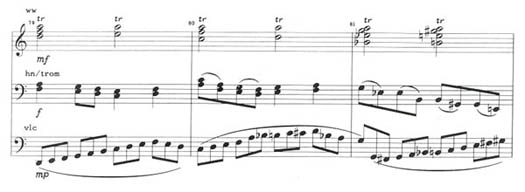
Written in triple counterpoint, with the melody sometimes above, below, or between the two accompaniments, the variations exhibit an impressive display of polyphonic writing. Even more notably, Hindemith's intricate orchestration allows every instrument the theme at least once while assigning most others, in addition, the two accompaniments, sometimes moving between two or all three levels in the same variation, as with the strings in Variation 6 (see Table 1).
Table 1
Instrumentation of "Turandot Scherzo" Variations
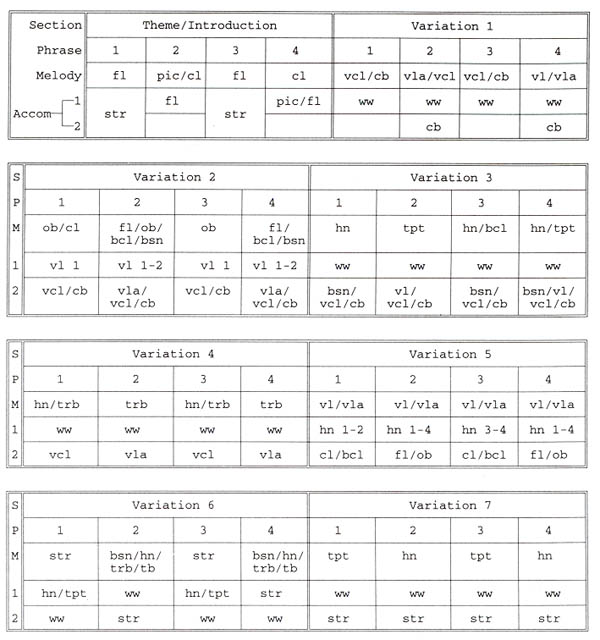
The Variation Section concludes in bar 147 on a climactic D major triad, which dissolves into "timeless" meandering triplets from Accompaniment 2. These, in turn, serve as a transition into the Fugato Section at measure 160, overlapping its entrance like its percussion prototype of bars 22-29. The D major triad is the most structurally significant portion of the piece. It falls, or seems designed to fall, exactly in the center of the "Turandot Scherzo," a hypothesis supported by dividing Hindemith's suggested tempo markings into the number of quarter or half notes contained in the piece and dividing again by 2.5 The midpoint also marks the beginning of Hindemith's departure from his von Weber model, whose form he had thus far adopted (see Table 2).
Table 2
Turandot Overture: Formal Scheme

"Turandot Scherzo" Introduction and Variation Sections: Formal Scheme

Thereafter relationships based on the golden section rather than additive ones dominate "Turandot Scherzo," with the most prominent structural events—the woodwind entry in the Fugato at bar 206 (as distinct from the transitional woodwind passage at bar 204), the Coda at bar 279, and the Recapitulation at bar 245—occurring at the golden section (GS) of their respective portions (see Table 3).6
Table 3
Golden Proportions in "Turandot Scherzo"

Besides its structural function, the D major triad serves even more significant antithetical functions integral to the principles underlying the work's construction by challenging F as the tonic and by representing the ultimate contrast to the preceding counterpoint with its harmonic unity, stability, and simultaneity. As for Hindemith's choice of D itself as an antithetical tonic, one should probably dismiss its traditional relationship to F, since associations of major and relative minor are nowhere else evident in the piece. Its selection most likely stemmed from the ambiguity of tonic exhibited in the Turandot theme itself, whose first bar can be heard equally in F major or D Minor. While the second bar affirms D as tonic, F gradually reassumes supremacy thereafter, exhibiting in microcosm the tonal plan of the work.
Yet in addition to its several inimical features, the D Major triad also offers a few less contrary. Assuming assimilation of Hindemith's ostensible method of thesis-antithesis-synthesis by this point in the piece, the chord fixes the listener's location in the movement by its temporal and harmonic significance. One knows, too, when the music will end (in 3 minutes and 18 seconds if Hindemith's tempi and proportions are strictly observed) and suspects how—by the reassertion of F as an unequivocal tonic of a simplified, if not major, tone system and by a resolution of the time/timelessness conflict posed by the Introduction and expanded by the Variation Section.
III
Despite the pervasive polyphony of the Variation Section, its greater focus is timbral display. The focus of the Fugato Section shifts decidedly to counterpoint, accompanied by several additional antitheses: (1) instead of F as a continuous tone center, the section presents a statement of the subject on virtually every pitch of the chromatic scale; (2) instead of the entire theme, the fugato subject is a foreshortened derivative enlivened by some jazzy syncopation—the thematic metamorphosis promised by the title; (3) instead of the theme's inherent modal ambiguity, the fugato subject is couched in unequivocal minor; and (4) instead of the entire orchestra, the brass and woodwind sections are employed independently. In addition, Hindemith often uses the first two measures of the subject (x) separately from the third (y) and combines repetitions or sequences of each to make structures like xxy or xyy (see Example 5).
Example 5

Like the variations the fugato begins softly and simply, accumulating textural and dynamic complexity as it proceeds (see Table 4).
Table 4
"Turandot Scherzo" Fugato Section: Formal Scheme
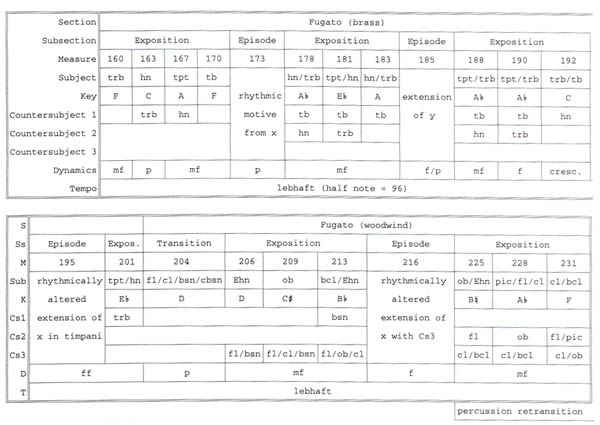
It opens traditionally with a four-voice exposition followed by an episode based on a rhythmic motive of x. For the rest of the fugato, however, the subject is constantly present either in full, extended, or abbreviated form, while subsequent episodes, instead of eschewing the subject, serve rather to develop or extend it. Paralleling the different accompaniments in the Variation Section are several strict countersubjects (Cs1, Cs2, and Cs3), of which the first two appear in the brass portion (see Example 6) and the third in the woodwind portion.
Example 6

The final exposition, in which identically harmonized and accompanied versions of the subject are stated by successive woodwind families on a series of descending minor thirds en route to the tonic F, crowns the contrapuntal complexity (see Example 7).
Example 7
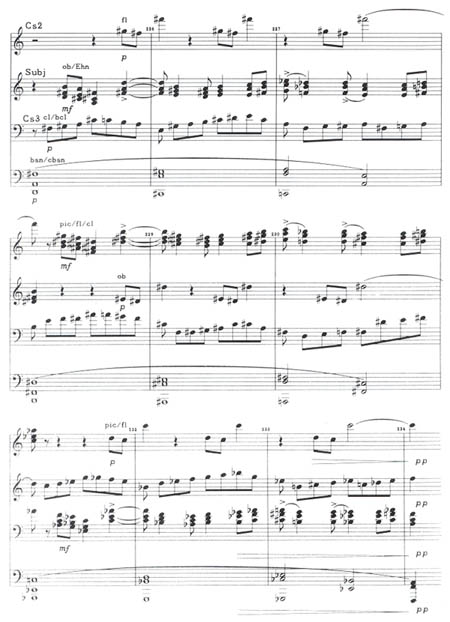
Pertinent to this study's premise, the Fugato Section may be said to represent a heightened rigidity of time relationships—other than a canon, little can be more temporally restrictive than a fugue with its orderly and relatively predictable procession of subjects, countersubjects, expositions, and episodes—while simultaneously foreshadowing the rhythmic disruption to follow in four places: (1) towards the end of the brass portion where the timpani repeats a seven-beat pattern of the x motive in bars 195-200 (see Example 8); (2) at the comparable location in the woodwind portion (bars 216-222) where the x motive makes 4 abortive entries on beat 4 rather than 2 before righting itself again by means of stretto in bar 223; (3) in the final exposition (bars 225-234) where a variant of Cs2 occurs in hemiola (see Example 7); and (4) in the fugue subject itself, where accented weak beats are the rule. Finally, not to be overlooked are the golden section relationships with their irrational proportions that govern the second half of the piece, contributing their own abstract, intuitive, and intangible sensation of timelessness to the proceedings.
Example 8
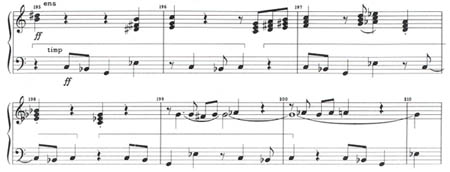
Functioning as the antithetical B portion or Development of this quasi sonata form, the Fugato Section gives way to the Recapitulation announced in bar 234 by the percussion transition from the Introduction, which begins almost imperceptibly before the end of the fugato much as it ended imperceptibly after the beginning of the variations. Complicating its overlapping 3¼-bar pattern are two additional patterns of 4 bars in the chimes and 3 bars in the timpani (later shortened to 2½ bars), whose repetitions are reminiscent of the varying cycles of the talea and color in an isorhythmic motet (see Example 9).
Example 9
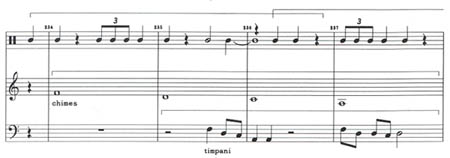
The Recapitulation synthesizes by simplifying. Reduced to only one phrase, the theme begins in the low strings as before. But instead of a new orchestration for every variation, the original instruments continue with the theme to be joined by additional ones in Variations 4-7. Paraphrases of their originals, accompaniments 1 and 2 undergo the same procedure of additive orchestration as the theme (see Table 5).
Table 5
"Turandot Scherzo" Recapitulation and Coda: Formal Scheme

A simplified theme is couched in a simplified tone system, F Mixolydian, although retaining the original's implied tonicization of the mediant (see Example 10).
Example 10

There is evidence, however, of a more fundamental synthesis. Hindemith's rhythmic disruption of the fourth bar of the Recapitulation theme (the 3/2 bar) begins to relate the "time-bound" Variation and Fugato Sections to the "timeless" Transition Sections. Even more significantly, the D major triad from the middle of the piece, considered to represent the polar opposite of a modal system on F, is modified at its comparable location in the Recapitulation (bar 274) to a  major triad, embracing F as its third.
major triad, embracing F as its third.
The final and most complete syntheses await the Coda. As the percussion instruments begin once more a variation of their disjunct cyclic rhythms from the retransition (see Example 9), the rest of orchestra abandons the Turandot theme to the timpani, with which it collaborates in a separate 2¾-bar rhythmic pattern (two bars of 2/2 plus one bar of 3/4). The orchestra's stuttered quarter-note chords summarize the tonal and timbral journey of the movement, departing from an ensemble F major triad and passing through combinations of increasing dissonance and varied orchestration involving all pitches of the combined Mixolydian and Locrian tone systems (see Example 11).
Example 11
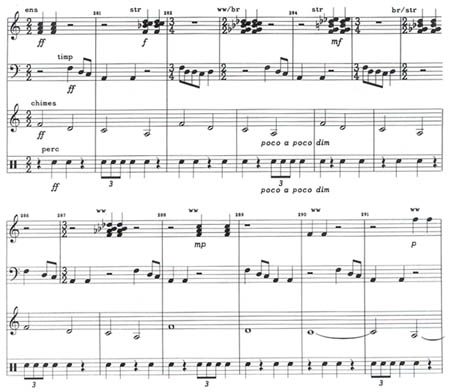
Upon the return to the F major triad in the woodwinds (bar 288), timbre and key are thereafter ultimately reduced to reiterated Fs in the solo piccolo. Meanwhile the already abbreviated theme in the timpani is diminished to its first four pitches while the ostinato of the same pitches in augmentation by the chimes begins to break up—first by syncopation, then by rests—before the winds' quiet conclusion on an F major chord.
Thus is the orchestra timbrally and rhythmically united for the first time. The percussion instruments, virtually banished from the wind portions to transitions between them earlier in the piece, exert an evolving and eventually overpowering complexity of rhythm that obscures, overturns, and finally destroys the natural accent promoted by the rest of the ensemble. They are the victors in this aural conflict; their timelessness vanquishing time—portraying in art much more effectively than in words the ageless appeal of an ancient Chinese air.
1Luther Noss, Paul Hindemith in the United States (Urbana: University of Illinois, 1989), 120. The sources are traced in an article by Wilfried Brennecke, "Die Metamorphosen-Werke von Richard Strauss und Paul Hindemith," Schweizerische Musikzeitung 103/4 (1963), 199-208. See also John Fenton, "Hindemith's Symphonic Metamorphoses," Music Teacher (February, 1978), 19-21.
2 See also Gene Anderson, "Musical Metamorphoses in Hindemith's 'March' from the Symphonic Metamorphosis of Themes by Carl Maria von Weber," Journal of Band Research, 30/1 (Fall, 1994), 1-10.
3A modern transcription of the melodies and an English translation of du Halde's text appear in Frank Harrison, Time, Place and Music: An Anthology of Ethnomusicological Observation c. 1550 to c. 1800 (Amsterdam: Frits Knuf, 1973), 161-66, 207-08; a critique of Rousseau's transcription and the tune's original Chinese notation appear in Jean-Benjamin de Laborde's Essai sur la musique ancienne et moderne, I (Paris, 1780), 145-147. See also Kii-Ming Lo, "In Search of a Chinese Melody: Tracing the Source of Weber's Musik zu Turandot, Op. 37," Tradition and Its Future in Music, Report of the Fourth Symposium of the International Musicological Society (Osaka: Mita, 1991), 511-20.
4The anomalous  and
and  of bar 3 and the A of bar 9 should probably be regarded as modifications of rather than departures from Mixolydianthe
of bar 3 and the A of bar 9 should probably be regarded as modifications of rather than departures from Mixolydianthe  and
and  as part of an applied dominant and the A as the lowered third of an altered tonic.
as part of an applied dominant and the A as the lowered third of an altered tonic.
5This results in 0.82 minutes (49 seconds) for the Introduction (108/132) + 5.81 minutes (5 minutes and 49 seconds) for the rest of the movement (558/96, including the 8 extra beats from 3/2 bars) for a total of 6.63 minutes (6 minutes and 38 seconds), whose midpoint is 3.315 minutes (3 minutes and 19 seconds). The D major triad comes at bar 119 of the Variations, having consumed 2.48 minutes (238/96) or 2 minutes and 29 seconds, which when added to the length of the Introduction of 0.82 minutes (49 seconds) equals 3.30 minutes or 3 minutes and 18 seconds.
6The golden section, or GS, can be illustrated by the division of a line in which the ratio of smaller to the larger equals the ratio of the larger to the whole (a/b = b/a+b). The GS of a line 1 unit long falls mathematically at .618..., an irrational number:

Fibonacci ratios, whose higher adjacent numbers (2, 3, 5, 8, 13, 21, etc.) approximate ever more closely the GS, are evident in the phrase structure of the fugato theme (2:3) and can be traced to the Turandot melody itself, whose structural asymmetry might be partially explained by the occurrence of B2 very near the GS (5:8) of the final 9 bars. For an introduction of the GS in music and proportional analysis in general, see Roy Howat, Debussy in Proportion (Cambridge: University of Cambridge, 1983). Concerning proportional structure in Hindemith, although not treating Symphonic Metamorphosis specifically, see analyses in David Neumeyer, The Music of Paul Hindemith (New Haven: Yale University, 1986) and the same author's "Tonal, Formal, and Proportional Design in Hindemith's Music," Music Theory Spectrum 9 (1987), 93-116.



